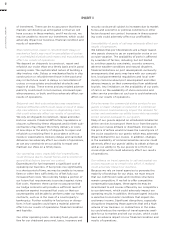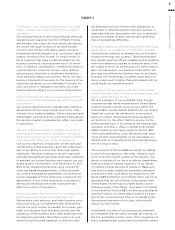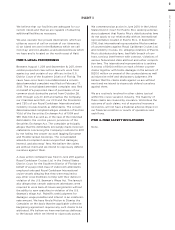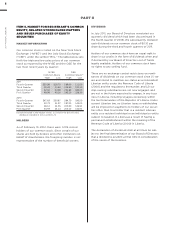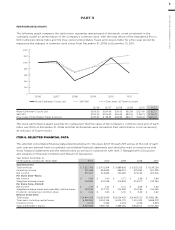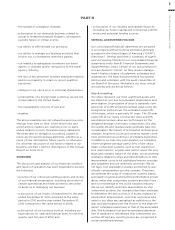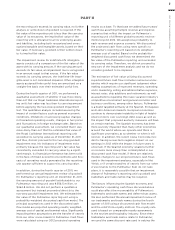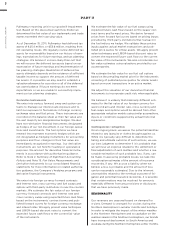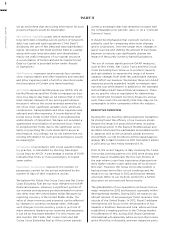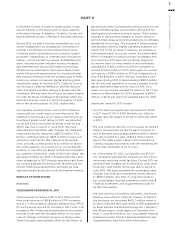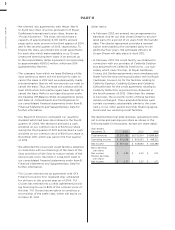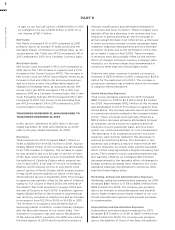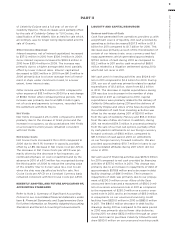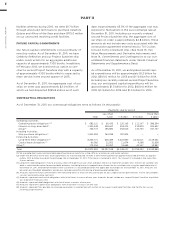Royal Caribbean Cruise Lines 2011 Annual Report Download - page 46
Download and view the complete annual report
Please find page 46 of the 2011 Royal Caribbean Cruise Lines annual report below. You can navigate through the pages in the report by either clicking on the pages listed below, or by using the keyword search tool below to find specific information within the annual report.
2011 ANNUAL REPORT 42
PART II
Pullmantur reporting unit in our goodwill impairment
test. Based on the discounted cash flow model we
determined the fair value of our trademarks and trade
names exceeded their carrying value.
As of December 31, 2011, Pullmantur had deferred tax
assets of €25.9 million, or $33.6 million, resulting from
net operating losses. We regularly review deferred tax
assets for recoverability based on our history of earn-
ings, expectations for future earnings, and tax planning
strategies. We believe it is more-likely-than-not that
we will recover the deferred tax assets based on our
expectation of future earnings and implementation of
tax planning strategies. Realization of deferred tax
assets ultimately depends on the existence of sufficient
taxable income to support the amount of deferred
tax assets. It is possible we may need to establish a
valuation allowance for a portion or all of the deferred
tax asset balance if future earnings do not meet
expectations or we are unable to successfully imple-
ment our tax planning strategies.
Derivative Instruments
We enter into various forward, swap and option con-
tracts to manage our interest rate exposure and to
limit our exposure to fluctuations in foreign currency
exchange rates and fuel prices. These instruments are
recorded on the balance sheet at their fair value and
the vast majority are designated as hedges. We also
have non-derivative financial instruments designated
as hedges of our net investment in our foreign opera-
tions and investments. The fuel options we have
entered into represent economic hedges which are
not designated as hedging instruments for accounting
purposes and thus, changes in their fair value are
immediately recognized in earnings. Our derivative
instruments are not held for trading or speculative
purposes. We account for derivative financial instru-
ments in accordance with authoritative guidance.
Refer to Note 2. Summary of Significant Accounting
Policies and Note 13. Fair Value Measurements and
Derivative Instruments to our consolidated financial
statements for more information on related authorita-
tive guidance, the Company’s hedging programs and
derivative financial instruments.
We enter into foreign currency forward contracts
and interest rate, cross currency and fuel swaps and
options with third-party institutions in over-the-counter
markets. We estimate the fair value of our foreign
currency forward contracts and interest rate and
cross currency swaps using expected future cash flows
based on the instruments’ contract terms and pub-
lished forward curves for foreign currency exchange
and interest rates. We apply present value techniques
and LIBOR-based discount rates to convert the
expected future cash flows to the current fair value
of the instruments.
We estimate the fair value of our fuel swaps using
expected future cash flows based on the swaps’ con-
tract terms and forward prices. We derive forward
prices from forward fuel curves based on pricing inputs
provided by third-party institutions that transact in
the fuel indices we hedge. We validate these pricing
inputs against actual market transactions and pub-
lished price quotes for similar assets. We apply present
value techniques and LIBOR-based discount rates to
convert the expected future cash flows to the current
fair value of the instruments. We also corroborate our
fair value estimates using valuations provided by our
counterparties.
We estimate the fair value for our fuel call options
based on the prevailing market price for the instruments
consisting of published price quotes for similar assets
based on recent transactions in an active market.
We adjust the valuation of our derivative financial
instruments to incorporate credit risk, when applicable.
We believe it is unlikely that materially different esti-
mates for the fair value of our foreign currency for-
ward contracts and interest rate, cross currency and
fuel swaps and options would be derived from other
appropriate valuation models using similar assumptions,
inputs or conditions suggested by actual historical
experience.
Contingencies—Litigation
On an ongoing basis, we assess the potential liabilities
related to any lawsuits or claims brought against us.
While it is typically very difficult to determine the
timing and ultimate outcome of such actions, we use
our best judgment to determine if it is probable that
we will incur an expense related to the settlement or
final adjudication of such matters and whether a rea-
sonable estimation of such probable loss, if any, can
be made. In assessing probable losses, we take into
consideration estimates of the amount of insurance
recoveries, if any. We accrue a liability when we
believe a loss is probable and the amount of loss
can be reasonably estimated. Due to the inherent
uncertainties related to the eventual outcome of liti-
gation and potential insurance recoveries, it is possible
that certain matters may be resolved for amounts
materially different from any provisions or disclosures
that we have previously made.
SEASONALITY
Our revenues are seasonal based on demand for
cruises. Demand is strongest for cruises during the
Northern Hemisphere’s summer months and holidays.
In order to mitigate the impact of the winter weather
in the Northern Hemisphere and to capitalize on the
summer season in the Southern Hemisphere, our brands
have increased deployment to South America and
Australia during the Northern Hemisphere winter months.


